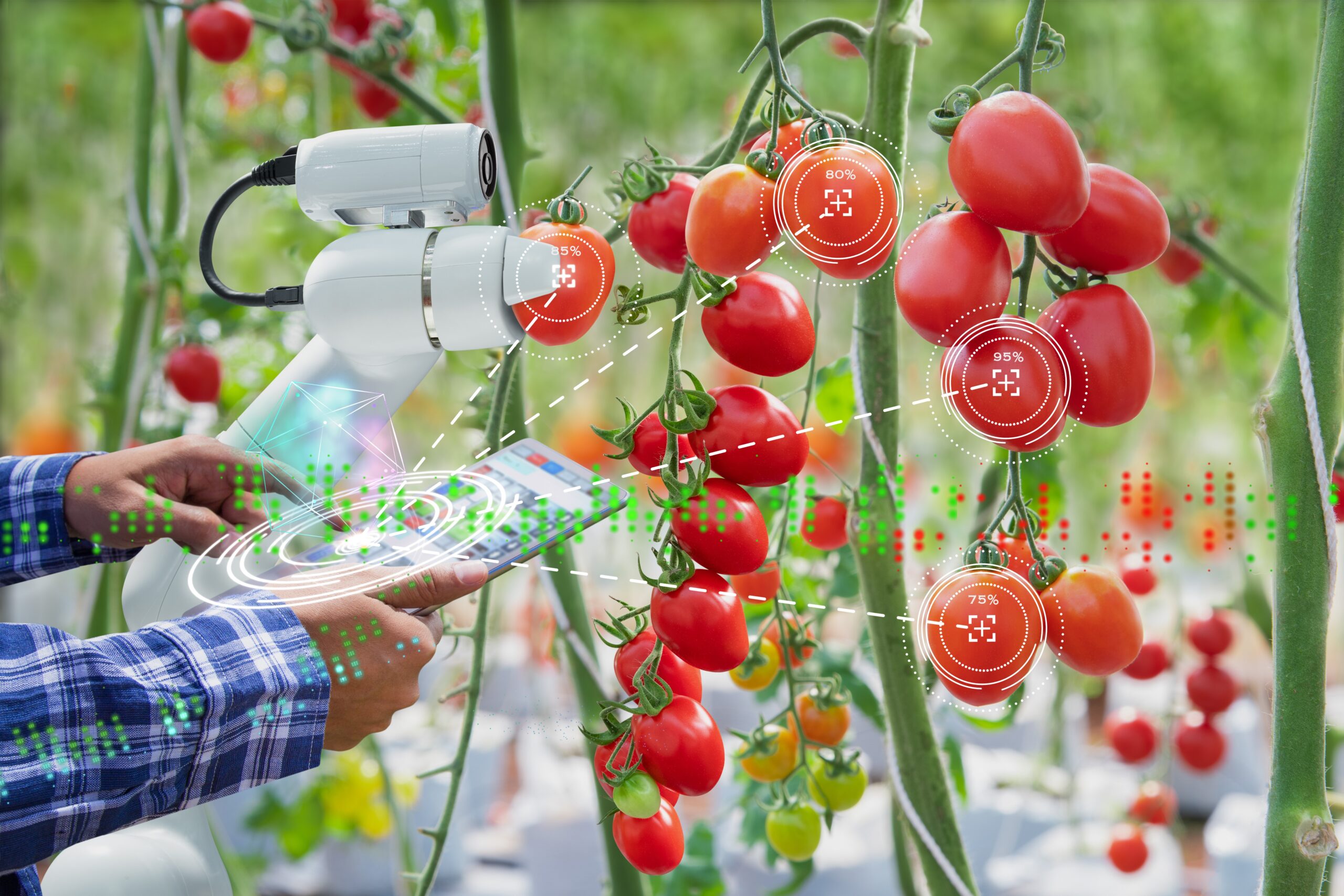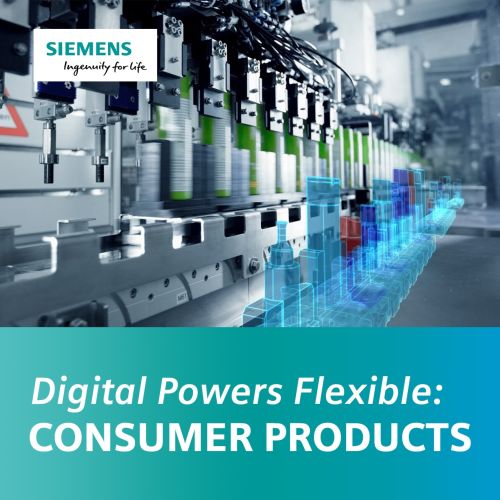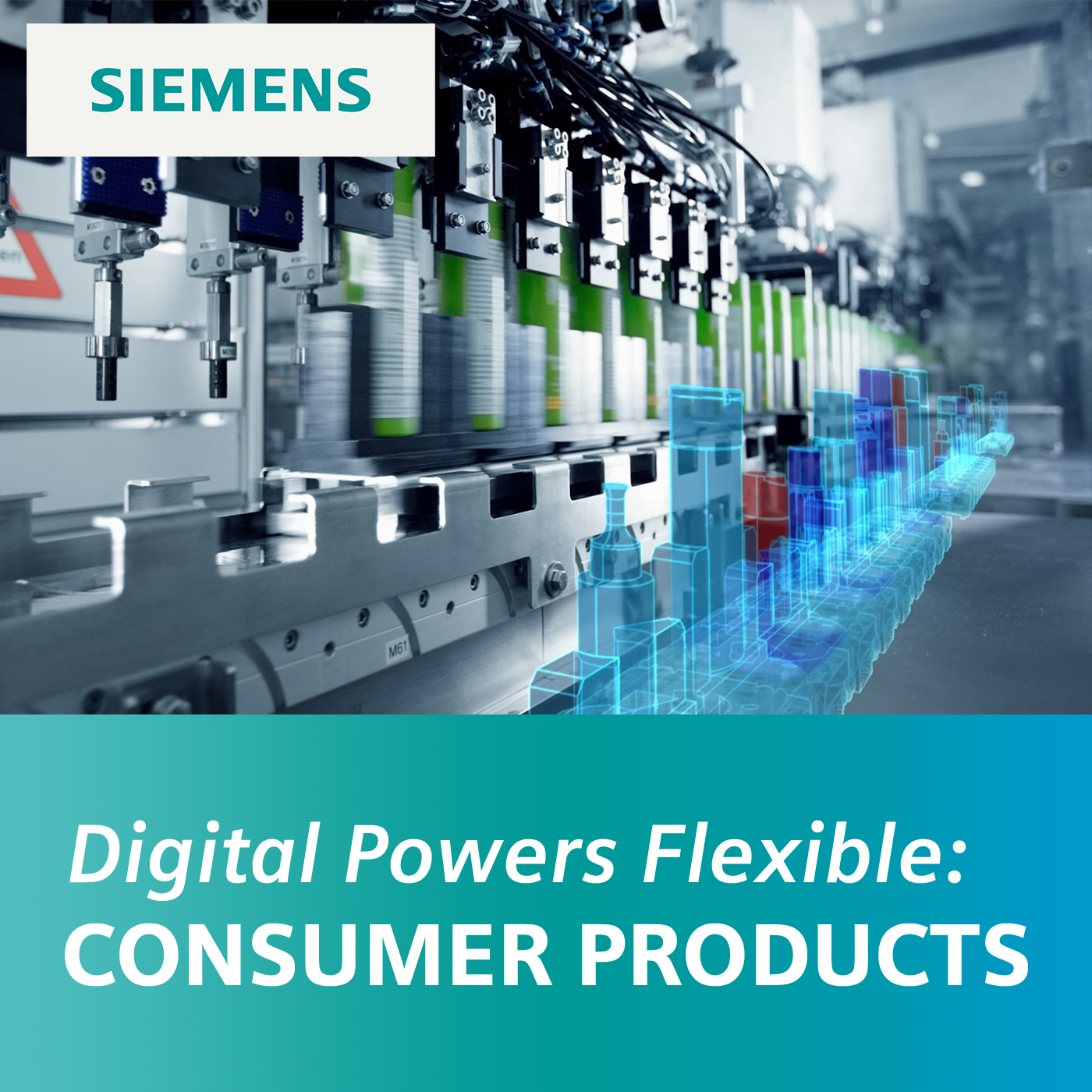Consumer Products Podcast – How digital threads help manufacturers thrive (Ep. 3)

The third episode of Siemen’s new consumer products podcast is here! Alastair and Suzanne are back to talk about three of the digital threads that are integral to consumer product development. In case you missed them, episode one discussed the growing trends of product personalization and the need for flexible processes that come with increased complexity. In episode two, Alastair and Suzanne continue the conversation by explaining how design simulation and generative design practices enable companies to make their product development more efficient and sustainable.
Summary
We’re living in a time where change happens fast. Whether it’s directed by the needs of consumers, changes in regulation or worldwide events like a pandemic, industries of every persuasion require the ability to adapt swiftly. When a single change to a product translates to hundreds, even thousands, of alterations in manufacturing specifications and procedures, how does an organization make those changes without significant financial consequences?
This is where product lifecycle intelligence comes into play. An integrated program including lifecycle management, smart product, and process design, and production design optimization is the difference between potentially crippling product alterations and seamless adaptation.
Riding the heels of our last episode, we’re back with Suzanne Kopcha who is responsible for industry strategy for consumer products, and Alastair Orchard, one of the first to shape the company’s digital enterprise portfolio. Today, we’re taking a deep dive into the digital threads that are helping companies stay competitive in a rapidly changing marketplace.
Some Questions I Ask:
- Can you tell us how smart product and process design works? (5:52)
- How is the apparel industry adjusting to the current market? (13:38)
- How do we create a completely integrated, seamless digital thread? (19:37)
What You’ll Learn in this Episode:
- How digital threads can be applied to products outside of the consumer market (1:02)
- A detailed explanation of the digital threads and their benefits (2:57)
- How a single change can ripple through the production process, and why traceability is so valuable (10:37)
- Why production design optimization presents a huge opportunity (14:33)
- Why digitalization shorted the gap between manufacturability and manufacturing efficiency (17:34)
Connect with Suzanne Kopcha:
Connect with Alastair Orchard:
Steve: Welcome back to Digital powers flexible, the Siemens podcast series about consumer goods. In the first two episodes of “Digital Powers Flexible,” we took a glimpse into the consumer products industry’s struggles to adapt to an ever-changing marketplace and looked at how a comprehensive digital twin can help turn these struggles into a competitive advantage
In this episode, we are deep-diving into each of these digital threads and we’ll talk about how they help companies with varying portfolios stay ahead in the ultra-competitive marketplace.
Suzanne, we’ve spent a lot of time today talking about consumer-packaged goods
Suzanne Kopcha: Let’s think about some other products because as we started this conversation, consumer products is very broad and diverse and the capabilities we’ve been talking about, really do resonate and help companies across that different diverse product portfolio. So we can use some examples that are different than the consumer packaged goods examples.
First of all, as we think about the threads, one of the things that is absolutely paramount to us is the thread of information. Within a thread and across the threads are captured by the collaboration backbone that we have in our solution set. We call that backbone ‘Teamcenter’. But what it really does is it offers a backbone of capability that makes a digital enterprise extensible across functions of your organization, but also with your suppliers. It can support your virtual organization and it’s absolutely critical to tie together, both the virtual world and the physical world. We don’t often talk about intelligence as one of the threads, and the reason for that is we almost take for granted that an absolutely essential part of our story is that every step of the process, every thread is designed and engineered to bring intelligence and responsiveness, to bring that flexibility that we’re looking for, to every part of the lifecycle. Lots of people are talking about product lifecycle intelligence right now. We just talk about lifecycle intelligence and we talk about using AI and machine learning. Alastair talked about how we use that in generative design, he just talked about how we use that in the manufacture of individual products. We think about the use of all of these capabilities across the entire lifecycle and bringing intelligence to each one. And I think that’s a really important differentiation.
So, let’s start at the beginning. Our first thread – we call it ‘Integrated Program Lifecycle Management,’ and those are a lot of words. What it really means is seamlessly integrating project and program management that all of these companies do when they want to bring new initiatives to market – and whether those are really complex initiatives or they’re really fast-track initiatives, and seamlessly integrating that with lifecycle information about how the products are designed, how they need to be manufactured with the information and body of evidence that supports all of that. The combination of this capability is enabling some of our customers to drive initiatives three times faster, to be able to increase the capacity of their innovation organizations to deal with 50% more initiatives than they could before and most importantly, giving them a very flexible and agile way of managing the IP in their innovation processes and being able to activate that for new initiatives in a very, very fast time – in a time that even six to 12 months ago, they never thought was possible. So, think about that first bookend as the ability to make the decisions about what products I should be designing, and how I can get them to market at what I used to consider warp speed, with all of the quality and traceability of the information that supports that. And when I want to make the next variant of that product, I have all that body of evidence, and I can start my new initiative, and only have to do 10 or 15% of the work that I would have had to do if I was doing it manually because I have all that context and traceability to be able to accelerate my initiative technical readiness. So that’s the first digital thread.
The second one, Alastair has talked a lot about. We call it ‘Smart Product and Process Design.’ We’ve talked a lot about the design process and the design, whether it’s a formulated product or it’s an electromechanical device, one of the most important challenges our customers face is how do I design the process of manufacturing for those products, regardless of the type of product they are, and be able to know exactly what recipe or we call it bill of process, that you need to be able to manufacture it at a specific plant on a specific line with a set of materials and components that I’ve gotten from my supply chain in that part of the world.
Steve Hartman: Alastair, do you want to talk about how we’re doing that?
Alastair Orchard: I’ll just make the point that even a small change to a product design – so this may be a tweak for a customer or it may be a change to a material because raw material prices have modified, maybe I’m making some kind of food product – a sauce and I use oils in there and maybe I want to move to unsaturated oils or maybe coconut oils are trendy and so I want to use those – just a modification to one of those ingredients can have an incredible knock-on effect through the entire organization. I was speaking recently to a customer and a simple material substitution requires almost 2000 manual touches before that change is now operational on the shop floor, which is clearly 2000 possible opportunities for error. It’s certainly slow and expensive, and actually, 40% of the factories that receive that new design are unable to manufacture because perhaps that oil, although theoretically, is just oil, at low temperatures – so, in northern parts of Europe, during the winter – the viscosity is much higher than the previous oil, and so all the pumps gum-up. And this is the kind of thing that designers do not or cannot really consider in the lab while they’re making something in a beaker. And the only way to address this is to go through a scale-up process, which is incredibly onerous, and, as I think I mentioned before, requires not only that production equipment is taken offline for these experiments, but that multiple batches, each one costing tens or hundreds of thousands of dollars are dumped until the design is validated and correct. And again, maybe that’s okay if I’m tweaking a product for the next five years. But if I’m trying to make one of something, I’ve got to get it right the first time. And so, we again, use generative design, we have the same design engineer on formulated products, so we’ll swap in maybe that coconut oil, we know everything about that oil – its price, its viscosity, its fat content, the way it reacts with the other components in the formulation – and so, we’ll reformulate that entire product around this substitution in order to optimize it for manufacturability. We will push that design out into our digital twins of our factory in order to see if we need to adjust pump curves if we need to mix for longer or shorter times in each factory – and we will take that single formulation, which is somehow the result of our design process, and we’ll go through what we call a recipe transformation of ingredients into actual materials that I can use in each one of my 400 factories of the setpoints, which were fine for the scale of a beaker to become specific to the equipment that I’m going to use in my factories and the steps in my recipe procedure, which again, were fine when I was in my laboratory, they’re going to be slightly different depending on the layout of my factories and the type of equipment I’m doing. And this is the onerous, expensive, time-consuming process that manufacturers have to go through today, and that is the barrier for innovative change. And so, we have this smart product and process design digital thread, which is there to streamline this process and ensure that the IPLM digital thread which has seen an opportunity in the market and said, “Okay, let’s go! Let’s do it!” is now supported by a digital thread, which creates, validates, transforms, and makes the design ready for manufacturing across the globe. Remember, if you introduce a new product in one factory, it’s going to get copied. In order to be profitable, you have to ramp up manufacturing globally and instantaneously – and that’s extremely difficult to do without a fully digital end-to-end process.
Suzanne Kopcha: One of the other, I think, really powerful benefits of Smart Product and Process Design is that body of evidence that I talked about before. And a very different type of value benefit, but something that our customers deal with every day is, when a material or a component that they use in their products is deemed no longer acceptable by a regulatory agency or even potentially hazardous, it can take months for organizations to just identify where that material exists within their supply chains. Is it in raw materials? Is it in semi-finished products? Has it been shipped to a country that no longer deems that material acceptable? Do they have to recall products? It’s a process that customers go through more times than they would like. With the capabilities and the traceability between Integrated Program Lifecycle Management and smart product and process design, we provide the body of evidence and the traceability of those materials to the products and variants of those products. That question, which in today’s manual world can take them weeks or months to answer can be found in seconds or minutes. What that does is, it builds trust and equity of the organization with regulatory bodies because they have that control over their information, it saves enormous productivity, but it also saves enormous dollars because oftentimes companies have to recall or scrap product because they can’t answer the question. So, lots of benefits, whether it’s in the scale-up in manufacturing of a single product, or even post, looking back on the data that you have to be able to go answer ongoing operational issues.
The next one that we talk about is ‘Production Design Optimization.’ We’ve touched on it many times already today, but it’s a single thread that really focuses on the design and optimization of the production environment so that it can truly be adaptable to make the changes that Alastair’s talked about, but it can also be visible so that we can design products in the context of what our manufacturing capabilities are, so that that scale-up recipe transformation process that Alastair talked about becomes viable. It allows for that to be able to be automated and takes a fraction of the time that it has today. And we’ve done that across consumer packaged goods, we work with several home appliance and tools companies around the design and simulation of their factory environment, the interaction between robotics and humans, the efficiency of those processes, and how they can maximize the throughput of their manufacturing with some of those simulation capabilities.
Steve Hartman: There is one industry that’s just embarking on this space – and that’s in the apparel industry.
Suzanne Kopcha: Right now, because of what’s happening with the pandemic, the supply chain for that industry has been just incredibly disrupted. In the US, 98% of the clothes that we wear every day are imported from Asian countries. A lot of that is going to be extremely constrained and a lot of organizations are looking at how do they design modern capability to be able to transform an entire industry, transform an entire industry’s business model, be able to move from manufacturing the majority of the products in Asian countries and having to submit those orders 18 months in advance, to being able to have consumer-driven product design and manufacturing that can be delivered in 48 to 72 hours. So, the ability to design those new modern manufacturing environments, and the ability to optimize them for the different kinds of products that will have to flow through in those very small quantities, is what production design and optimization is all about. And I think it’s a huge opportunity in every segment of this industry. Oftentimes, plants are owned and operated locally – and that’s for good reason because they can ensure that they optimize the cost of the manufacturing facility and the total deliberate cost of product out of it. But, if visibility is not known, if management of what the equipment is, in a plant on a line, what its capability is, what its capability is not, is not visible to the rest of the organization. We can’t automate a lot of the processes that customers really want to. So, I believe that this is going to be a significant opportunity in the future as companies are ramping up manufacturing, post the pandemic, being able to truly ensure that they can design their manufacturing facilities and deliver against the new regulations around social distancing is going to be absolutely essential. And this digital thread is today helping customers prepare for that, and I think will be hugely important in the acceleration and ramp-up of manufacturing across the world.
Alastair Orchard: It’s interesting you mentioned social distancing. We’re involved right now in valuating using our simulation tools the most efficient way, that manufacturers can reopen their manufacturing facilities and guarantee this 2-meter distance between operators – How many operations staff can I bring to bear in a particular line without breaking those social distancing rules? Which doorways do I have to close? Which new doorways do I have to open? A certain corridor is going to be one way in order to avoid contact. And so, this has added an additional dimension to the question of planning, manufacturing, and planning the layout to the factories, but we’re kind of taking in our stride. So, that’s incredibly interesting.
Suzanne Kopcha: I think your comments are absolutely spot on, Alastair, around the pilots that we’re doing around social distancing, and how people can design their manufacturing facilities. my phone keeps ringing in terms of the customers that are interested in this capability and the incredible need that people have for new digital capabilities to be able to ramp up as fast as they need. And, what we’re seeing all over is they can’t even consider how they would do this manually across the landscape and the speed that they want to ramp up. So, the digital capabilities to do this are really viewed as an imperative.
Alastair Orchard: Another factor to consider is that, in many cases, the best case for a manufacturer is that their design and manufacturing divisions are somehow two separate domains within their own organization. But that’s not even a starting point for many industries. So, you mentioned apparel. In most cases, design and manufacturing are two different companies. The same goes for electronics. So all the electronics that you know and love that, let’s say, are designed in California, of course, we know that they’re not manufactured in California, they’re manufactured by different companies, which adds a massive challenge to the whole question about manufacturability and manufacturing efficiency. And so, digitalization acts as not only an enabler, but an essential link between not two divisions within the same company, but between two collaborating companies potentially sitting in different parts of the world. And so, a digital environment is a common space where IP security becomes a big question then and this is why our digital enterprise focuses on information security and allows companies to release designs securely to manufacturers to collaborate around manufacturability in order to lower the overall cost of bringing a product to market. The other aspect is, even if I own my own manufacturing, I can go back to Siemens for this, although we know absolutely this, it’s the same for any consumer product. If I go back to my factory, we own that factory, but we did not build the machines for that factory. If you’ve ever seen a photo of the factory, then it looks very homogenous, all the machines are the same color, but actually, they come from about 40 different machine suppliers.
Steve Hartman: So, how do we create a completely integrated, seamless digital thread? How do we optimize and design production when we’re not even supplying the machines?
Alastair Orchard: Well, it’s done through a very transparent supplier relationship, again, based around the digital twin. So when we need to acquire any machine, we write a specification – we do not expect a written answer. So, maybe we’ll go to tender with 10 machine builders, we expect a digital twin in response to our request.
Steve Hartman: Thank you both for starting the discussion about digital threads and how they help manufacturers of consumer goods thrive in this era.
In this episode, we covered: Integrated Program Lifecycle Management, Smart Product and Process Design and Production Design Optimization
We will continue with more digital threads in the fourth and last episode which cater to the need for flexible manufacturing but also the need for supply chain resiliency.
Changes, even small ones, made to large-scale production lines can produce an incredible knock-on effect. Whether the change was to customize a product for a customer, or a specific ingredient is no longer viable because of national regulation or a price increase on the raw material, changing that single ingredient can require as many as 2000 manual tweaks before the new process is operational on the manufacturing floor. That is nearly 2000 opportunities to make a mistake in the process execution. Even changing just the oil in a tomato sauce or skin lotion can lead to unexpected problems. Is the new viscosity too high for current process temperatures? Will the machines get gummed up during winter months because the new oil has a lower viscosity?
These are tough questions to ask a design engineer in a lab to account for, across the globe and in very different process environments, especially if each product is run in smaller lot sizes. There is no room for error when working with lot sizes of one. The solution is digital: All this design work can be handed off to the digital twin – a virtual representation of a physical product. As an example, swapping in a coconut oil, we know everything about that material – its price, its viscosity, its fat content and how it reacts with the other components in the formula. The product can then be reformulated virtually to work around this substitution and optimize the process for manufacturability. Does the pump speed need to change? Does the formulation need more time to mix?
On top of that, there are likely multiple factories producing the same thing around the world. How does the local environment effect the process’s manufacturability? This is just some of the power of the Smart Product and Process Design Digital Thread. For more information on this thread and some of the other relevant solutions in consumer product manufacturing, make sure to read the full transcript or listen to the podcast.
Interested in a specific digital thread for your business? Here are the first three Alastair and Suzanne discuss for the consumer products industry in this episode:
Integrated program lifecycle management (3:00)
“…seamlessly integrating project and program management that all of these companies do when they want to bring new initiatives to market… integrating that with lifecycle information about how the products are designed, how they need to be manufactured with the information and body of evidence that supports all of that.”
Smart product and process design (5:00)
“…whether it’s a formulated product or it’s an electro-mechanical device, one of the most important challenges our customers face is how do I design the process of manufacturing for those products… you need to be able to manufacture it at a specific plant on a specific line with a set of materials and components that I’ve gotten from my supply chain in that part of the world.”
Production design optimization (12:20)
“…a single thread that really focuses on the design and optimization of the production environment so that it can truly be adaptable to make… changes. It allows for that to be able to be automated and takes a fraction of the time that it has today.”

Suzanne Kopcha – Speaker
Suzanne has been a part of Siemens for over five years and is responsible for industry strategy for consumer products; before joining Siemens, she spent 25 years at Procter & Gamble.

Alastair Orchard – Speaker
Alastair runs the Digital Enterprise Thought Leadership team for Siemens Digital Industries, working with multinationals to become more flexible, cost effective, transparent, collaborative organizations, and to bring their world-class products to market faster than their competitors.

Steve Hartman – Host
Steve has been at Siemens for over two years and is responsible for writing various content as well as producing videos and podcasts.

Digital Powers Flexible
Digital Powers Flexible: Consumer Products is a podcast brought to you by Siemens Digital Industry Software.
